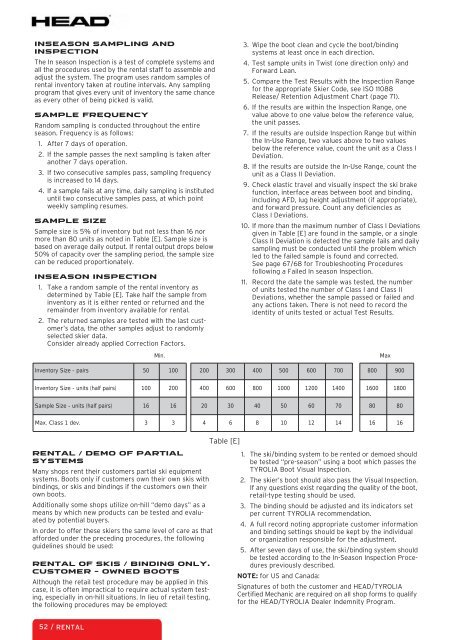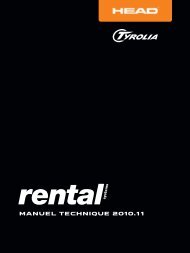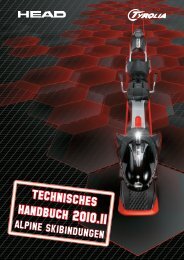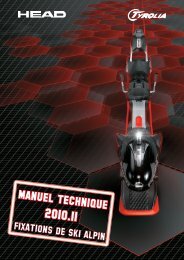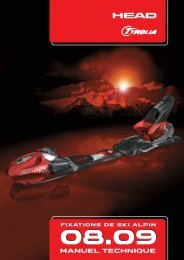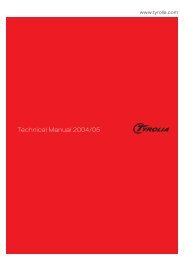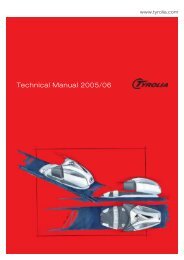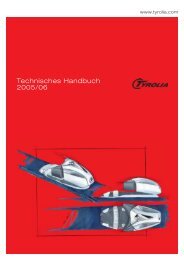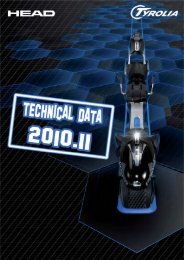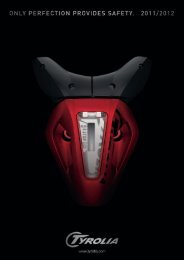Create successful ePaper yourself
Turn your PDF publications into a flip-book with our unique Google optimized e-Paper software.
INSEASON SAMPLING AND<br />
INSPECTION<br />
The In season Inspection is a test of complete systems and<br />
all the procedures used by the rental staff to assemble and<br />
adjust the system. The program uses random samples of<br />
rental inventory taken at routine intervals. Any sampling<br />
program that gives every unit of inventory the same chance<br />
as every other of being picked is valid.<br />
SAMPLE FREQUENCY<br />
Random sampling is conducted throughout the entire<br />
season. Frequency is as follows:<br />
1. After 7 days of operation.<br />
2. If the sample passes the next sampling is taken after<br />
another 7 days operation.<br />
3. If two consecutive samples pass, sampling frequency<br />
is increased to 14 days.<br />
4. If a sample fails at any time, daily sampling is instituted<br />
until two consecutive samples pass, at which point<br />
weekly sampling resumes.<br />
SAMPLE SIZE<br />
Sample size is 5% of inventory but not less than 16 nor<br />
more than 80 units as noted in Table [E]. Sample size is<br />
based on average daily output. If rental output drops below<br />
50% of capacity over the sampling period, the sample size<br />
can be reduced proportionately.<br />
INSEASON INSPECTION<br />
1. Take a random sample of the rental inventory as<br />
determined by Table [E]. Take half the sample from<br />
inventory as it is either rented or returned and the<br />
remainder from inventory available for rental.<br />
2. The returned samples are tested with the last customer’s<br />
data, the other samples adjust to randomly<br />
selected skier data.<br />
Consider already applied Correction Factors.<br />
RENTAL / DEMO OF PARTIAL<br />
SYSTEMS<br />
Many shops rent their customers partial ski equipment<br />
systems. Boots only if customers own their own skis with<br />
bindings, or skis and bindings if the customers own their<br />
own boots.<br />
Additionally some shops utilize on-hill “demo days” as a<br />
means by which new products can be tested and evaluated<br />
by potential buyers.<br />
In order to offer these skiers the same level of care as that<br />
afforded under the preceding procedures, the following<br />
guidelines should be used:<br />
RENTAL OF SKIS / BINDING ONLY.<br />
CUSTOMER - OWNED BOOTS<br />
Although the retail test procedure may be applied in this<br />
case, it is often impractical to require actual system testing,<br />
especially in on-hill situations. In lieu of retail testing,<br />
the following procedures may be employed:<br />
52 / RENTAL<br />
3. Wipe the boot clean and cycle the boot/binding<br />
systems at least once in each direction.<br />
4. Test sample units in Twist (one direction only) and<br />
Forward Lean.<br />
5. Compare the Test Results with the Inspection Range<br />
for the appropriate Skier Code, see ISO 11088<br />
Release/ Retention Adjustment Chart (page 71).<br />
6. If the results are within the Inspection Range, one<br />
value above to one value below the reference value,<br />
the unit passes.<br />
7. If the results are outside Inspection Range but within<br />
the In-Use Range, two values above to two values<br />
below the reference value, count the unit as a Class I<br />
Deviation.<br />
8. If the results are outside the In-Use Range, count the<br />
unit as a Class II Deviation.<br />
9. Check elastic travel and visually inspect the ski brake<br />
function, interface areas between boot and binding,<br />
including AFD, lug height adjustment (if appropriate),<br />
and forward pressure. Count any deficiencies as<br />
Class I Deviations.<br />
10. If more than the maximum number of Class I Deviations<br />
given in Table [E] are found in the sample, or a single<br />
Class II Deviation is detected the sample fails and daily<br />
sampling must be conducted until the problem which<br />
led to the failed sample is found and corrected.<br />
See page 67/68 for Troubleshooting Procedures<br />
following a Failed In season Inspection.<br />
11. Record the date the sample was tested, the number<br />
of units tested the number of Class I and Class II<br />
Deviations, whether the sample passed or failed and<br />
any actions taken. There is not need to record the<br />
identity of units tested or actual Test Results.<br />
Min. Max<br />
Inventory Size - pairs 50 100 200 300 400 500 600 700 800 900<br />
Inventory Size - units (half pairs) 100 200 400 600 800 1000 1200 1400 1600 1800<br />
Sample Size - units (half pairs) 16 16 20 30 40 50 60 70 80 80<br />
Max. Class 1 dev. 3 3 4 6 8 10 12 14 16 16<br />
Table [E]<br />
1. The ski/binding system to be rented or demoed should<br />
be tested “pre-season” using a boot which passes the<br />
TYROLIA Boot Visual Inspection.<br />
2. The skier’s boot should also pass the Visual Inspection.<br />
If any questions exist regarding the quality of the boot,<br />
retail-type testing should be used.<br />
3. The binding should be adjusted and its indicators set<br />
per current TYROLIA recommendation.<br />
4. A full record noting appropriate customer information<br />
and binding settings should be kept by the individual<br />
or organization responsible for the adjustment.<br />
5. After seven days of use, the ski/binding system should<br />
be tested according to the In-Season Inspection Procedures<br />
previously described.<br />
NOTE: for US and Canada:<br />
Signatures of both the customer and HEAD/TYROLIA<br />
Certified Mechanic are required on all shop forms to qualify<br />
for the HEAD/TYROLIA Dealer Indemnity Program.


